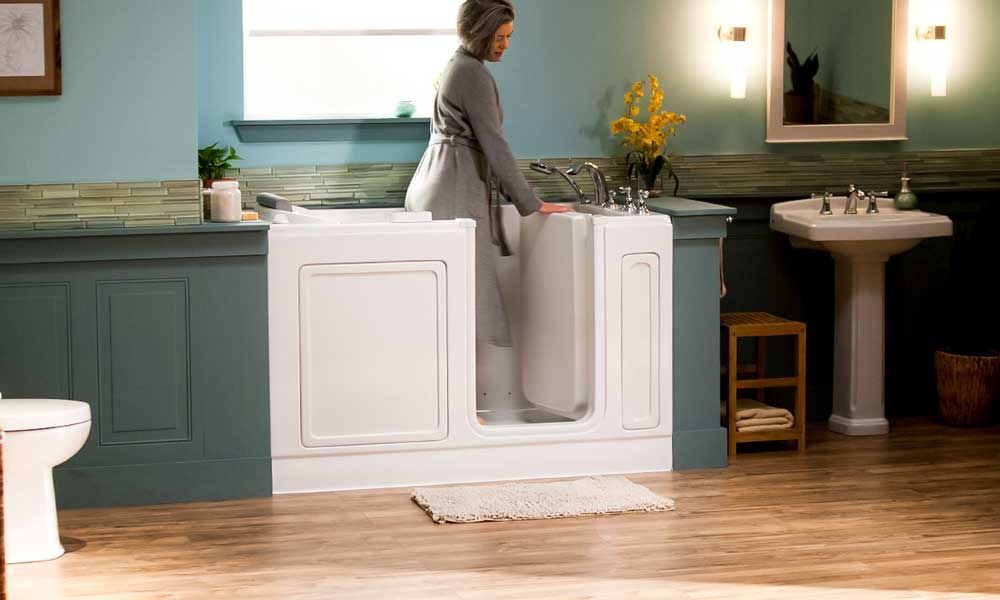A walk-in tub is a bathtub with a watertight door that allows you to enter over a low threshold, rather than stepping over the traditional tub wall. The door closes, the tub fills with water, and after draining the bath, you open the door and step out safely.
The benefits of walk-in tubs for bathers with limited mobility are huge. The best walk-in tubs are safer than traditional tubs, they’re comfortable, and they offer a range of health benefits. But they’re also expensive—and not entirely without risk.
So are walk-in tubs worth the money? Let’s break down the pros and cons of walk-in tubs to see if it’s the right option for you.
Walk-In Tub Safety
Pro: Walk-In Tubs Meet ADA Requirements
The primary appeal of walk-in tubs is their increased safety for bathers with limited mobility. These tubs are designed to meet ADA requirements and reduce the risk of falls. This is critical for seniors: One in four older adults falls each year—and 80% of those falls are in the bathroom.
Some of the core walk-in tub features that help reduce falls include:
- A lower threshold for entering (just a few inches)
- Grab bars and handrails
- Contoured built-in seating (sometimes heated)
- Anti-slip flooring
- Wider doors for safer wheelchair access
- Handheld shower unit or removable shower head for easier bathing
Another safety feature, although not related to falls, is a scald prevention valve designed to prevent hot water burns.
Con: They’re Not Entirely Risk-Free
Are walk-in tubs safe? Absolutely. But they’re not entirely without risk. While they’re safer than traditional tubs, there are a few downsides:
- Chilling: To properly use a walk-in tub, you have to enter before the water fills and wait to exit until it’s fully drained. For older adults, who have thinner skin and slower circulation, this could lead to hypothermia, especially during the draining process when their skin is wet. We recommend drying off with a towel as the tub drains to reduce the risk of chilling. You can also purchase more expensive fast-draining tubs to avoid this risk.
- Flooding: Some walk-in tubs have swing-in doors—the doors swing into the tub when you enter. Those with swing-out doors, however, pose a flooding risk. If you don’t properly latch the door, the pressure of the water as it fills could push the door open and flood your bathroom.
- Anti-scald valve failure: The anti-scald valve limits the heat of the water so that you won’t burn yourself while bathing. If the valve fails, however, you’ll need to act quickly to ensure the water is not too hot.
From Our Expert: Tubs that meet ADA requirements are great, but some people will benefit from more personalization than ADA requirements account for. Limited door widths are often classified as a walk-in tub ADA feature, but they may impact your ability to use a mobility device such as a cane or walker. And built-in seats may cause some individuals to feel like they are “floating” while soaking. Remember, ADA requirements are not a requirement for the home, but rather for public spaces to meet the bare minimum requirements to accommodate a wide range of abilities and disabilities. Take caution in choosing your features, and consult a manufacturer specialist to learn the positives and negatives of all the tubs’ elements.
Dawn Heiderscheidt, OTR/L, ECHM, CAPS
Walk-In Tub Water Usage
Pro: Walk-In Tubs Have a Faster Fill Time
Because you have to get in a walk-in tub before turning the water on, you’ll have to sit while the water fills. Fortunately, several leading brands have quickened the fill process.
Today, walk-in tubs can fill in as few as six to eight minutes, depending on the size of the tub. The typical walk-in tub water capacity is about 50 to 80 gallons (traditional tubs hold between 30 and 60).
Some of the more luxurious walk-in tubs offer heated seats and backrests to keep you warm while you wait for the water to fill.
Con: Greater Water Capacity May Require System Upgrades
Walk-in tubs are visibly deeper than regular tubs, but that doesn’t always mean they require more water. The built-in bench actually takes up a good portion of the volume of the tub, and many walk-in tubs are narrower than traditional tubs. That means the water capacity between the two types can be quite similar.
That said, if your walk-in tub water capacity is on the high end (around 80 gallons), you may need to upgrade your water heater to a larger tank size—a cost that can reach $5,000 and will result in higher utility bills.
Another downside to higher-capacity walk-in tubs is their drain time. Some walk-in tubs can take between 15 and 20 minutes to drain, which is an inconvenient and potentially dangerous byproduct if you get too cold.
Some brands, including Kohler, Elevate, American Standard, AmeriGlide, and Ella’s Bubbles, offer fast-draining technology, reducing the drain time to a matter of minutes—or seconds. Just be prepared to pay more for these models.
Walk-In Tub Costs
Pro: Walk-In Tubs Offer More Value for the Money
There’s no getting around it: Walk-in tubs are expensive. But that’s understandable, given the extra features they offer over traditional tubs.
Rather than outfitting an existing tub with one-off features to make the experience safer—self-installed tub seats, anti-scald valves, and non-slip flooring, for instance—walk-in tubs come fully equipped with these safety measures, up to the ADA’s standards. Even the base models have everything you need.
And if you pay for a higher-end model, you might enjoy additional walk-in tub benefits like:
- A heated seat and backrest
- Water jets or air jets
- Chromatherapy
- Aromatherapy
- A foot massager
- In-line heating
Con: Installation Costs Are High
The cost of walk-in tubs start around $2,000 for a basic soaker but can go as high as $25,000 for a two-person tub with spa-level features. Depending on the model, some buyers must also consider home modification requirements before installing the tub to ensure it fits and can function properly.
Ultimately, the price comes down to the brand, size, and features you choose—plus local labor rates for installation and any remodeling required to install the tub in your current setup.
On average, budget between $7,000 and $12,000 for a new walk-in tub, including installation. Unfortunately, walk-in tubs aren’t considered durable medical equipment, so you won’t get help with the cost from Medicare.
To protect your investment, clean and properly maintain your walk-in tub to ensure it provides a sanitary bathing experience and lasts for years to come.
Walk-In Tub Comfort and Health Benefits
Safety and cost are the main talking points when balancing the pros and cons of walk-in tubs, but where these soakers really shine is in their comfort and health benefits.
If you have a larger budget when choosing a walk-in tub, prioritize the features that first suit your health and mobility needs first. Then, focus on the features that enhance your comfort and experience, like seats and thresholds. It can be tempting to spend money on features that look or feel amazing, but if you can not access the tub, or the features of the tub exacerbate other issues, the experience may be less than you desire.
For instance, many walk-in tubs have hydrotherapy jets similar to what you would find in an outdoor hot tub. Several jets of heated water and air agitate the water and massage your muscles. This is especially helpful for seniors recovering from amputations or dealing with conditions like arthritis, rheumatism, fibromyalgia, and general muscle or joint pain and stiffness.
Other therapeutic options include aromatherapy (mixing essential oils into the water for a relaxing scent) and chromatherapy (subdued lighting that makes the experience more relaxing).
Conclusion: Are Walk-In Tubs Worth the Money?
Walk-in tubs may carry a high price tag, but they offer enhanced safety for seniors who are prone to falls, plus additional features that increase comfort and offer added health benefits. This alone makes walk-in tubs worth the cost for some people and certain medical conditions.
If you’re thinking about installing a walk-in tub for yourself or for an aging parent, start with our list of the best walk-in tubs, then read independent reviews of any models you’re considering. Make a list of your must-have features, and set a realistic budget so you can narrow down your search.



